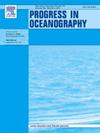亚北极太平洋东部冬季-春季流域尺度浮游动物组成
IF 3.6
3区 地球科学
Q1 OCEANOGRAPHY
引用次数: 0
摘要
关于亚北极太平洋东部浮游动物分布的知识有限,这阻碍了我们评估生态系统水平变化的能力。为了提供基本信息和增加我们对ESP浮游动物生态的认识,在冬季至早春的三个考察中,研究了大尺度的浮游动物动态。2019年(2月19日至3月15日)和2020年(3月12日至4月4日)在北纬47.5°以北和西经147.5°以东收集了邦戈镇(0.6 m口直径,250µm网),并在2022年(2月6日至4月17日)进行了第三次调查,将覆盖范围向西扩大到西经172°。一般加性模型确定了阿拉斯加环流中浮游动物丰度低、小型浮游动物生物量低的区域。属丰度的聚类分析主要沿着温度梯度分离样品。集群大致分为冷(<7°C)和暖(>7°C)组合。低温组合群以亚北极类群为主,其组成表明北太平洋洋流分叉以北的浮游动物结构具有广泛的一致性,其变化受环流环流和邻近洋流系统的输入驱动。温暖组合群主要与NPC分支相关,并以亚北极、加利福尼亚流和过渡带分类群混合为特征。阿拉斯加环流中物种组成和生物量的差异,以及北部ESP和NPC分支之间的差异,包括与分支相关的小型浮游动物生物量的增加,为了解ESP中浮游动物的觅食景观提供了线索。本文章由计算机程序翻译,如有差异,请以英文原文为准。
Basin-scale zooplankton composition in the Eastern Subarctic Pacific in the winter-spring
Knowledge of zooplankton distributions in the Eastern Subarctic Pacific (ESP) is limited and hinders our ability to assess ecosystem level change. To provide baseline information and increase our understanding of zooplankton ecology in the ESP, large-scale winter to early spring epipelagic zooplankton dynamics were investigated as part of three expeditions. Bongo tows (0.6-m mouth diameter, 250 µm mesh) were collected in 2019 (19 February – 15 March) and 2020 (12 March – 4 April) north of 47.5°N and east of 147.5°W and during a third survey in 2022 (6 February – 17 April), which expanded coverage westward to 172°W. General Additive Models identified a region of low zooplankton abundance and low biomass of small zooplankton in the Alaska Gyre. Cluster analysis of genus abundances separated samples largely along a temperature gradient. Clusters were broadly grouped into cool (<7 °C) and warm (>7 °C) assemblages. Cool assemblage clusters were dominated by subarctic taxa and their composition suggested a broad coherence in zooplankton structure north of the bifurcation of the North Pacific Current (NPC), with variation driven by the circulation of the gyre and inputs from neighbouring current systems. Warm assemblage clusters were primarily associated with the NPC bifurcation and were characterized by a mix of Subarctic, California Current, and Transition Zone taxa. Differences in species composition and biomass across the Alaska Gyre and between the northern ESP and the NPC bifurcation, including increased biomass of small zooplankton associated with the bifurcation, give insight into the foraging landscape that supports planktivores in the ESP.
求助全文
通过发布文献求助,成功后即可免费获取论文全文。
去求助
来源期刊

Progress in Oceanography
地学-海洋学
CiteScore
7.20
自引率
4.90%
发文量
138
审稿时长
3 months
期刊介绍:
Progress in Oceanography publishes the longer, more comprehensive papers that most oceanographers feel are necessary, on occasion, to do justice to their work. Contributions are generally either a review of an aspect of oceanography or a treatise on an expanding oceanographic subject. The articles cover the entire spectrum of disciplines within the science of oceanography. Occasionally volumes are devoted to collections of papers and conference proceedings of exceptional interest. Essential reading for all oceanographers.
 求助内容:
求助内容: 应助结果提醒方式:
应助结果提醒方式:


